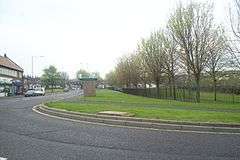Thorney Close
Thorney Close is a suburb of Sunderland, Tyne and Wear in England.
| Thorney Close | |
|---|---|
 Thorndale Road, Thorney Close | |
 Thorney Close Location within Tyne and Wear | |
| Population | 9,938 |
| Metropolitan borough | |
| Metropolitan county | |
| Region | |
| Country | England |
| Sovereign state | United Kingdom |
| Post town | SUNDERLAND |
| Postcode district | SR3 |
| Police | Northumbria |
| Fire | Tyne and Wear |
| Ambulance | North East |
| UK Parliament | |
It is located on the northern edge of the A690 (Durham Road), and borders with Grindon to the north and Herrington to the south, and the A19 to the west.
Work began on the council estate in 1947 and the first 77 houses were completed in 1948. In 1971 the population had risen to just under 14,000.[1] According to the 2001 Census, the population was 9,938, with 36.7% living in council houses.[2] In the 2011 Census the population was 11,125, as reported as part of the Sandhill ward.[3]
The estate has three shopping arcades, a community centre, one working men's club, a recently built residential home for the elderly, three Methodist churches, and two primary schools, and a secondary school which was rebuilt in 2003. The former secondary school site is host to the new school, community centre, the local branch library, which was moved from Grindon and a walk in health centre.
Most of the streets in Thorney Close begin with the letter "T". Such as, Telford Road, Twickenham Road, Thorney Close Road, Taunton Square & Tadcaster Road.
Deprivation
According to the Indices of Deprivation published by the Department of the Environment, Transport and the Regions in 2000, Thorney Close ranks worst of all twenty-five wards in Sunderland for Income, Employment (55th most deprived ward in England), and Child Poverty (147th most deprived ward in England). It is second most deprived ward in Sunderland overall, behind Southwick However locals do rank Pennywell, Hendon, Witherwack, Carley Hill, Redhouse etc. as areas of worse deprivation.
In Popular Culture
The estate was the feature location of a short-horror story "The Curse of Thorney Close" which embedded themes of poverty, crime and desperation into a tale of witchcraft in the area.[4][5]
References
- "Diamond date for Thorney Close". Sunderland Echo. Archived from the original on 7 January 2007. Retrieved 16 January 2007.
- "Thorney Close 2001 Census Ward Card" (PDF). Sunderland City Council. Archived from the original (PDF) on 27 September 2007. Retrieved 16 January 2007.
- "Custom report (Sandhill Ward) - Nomis - Official Labour Market Statistics". www.nomisweb.co.uk. Retrieved 3 October 2019.
- Phantasmal Horror Stories: The Curse of Thorney Close
- Sunderland's First Horror Story: The Curse of Thorney Close